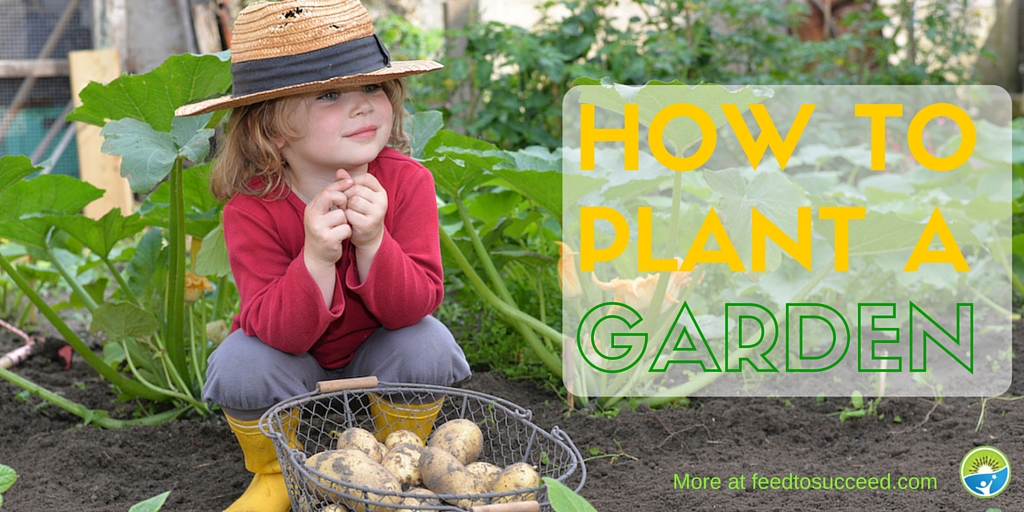There are so many reasons to plant a garden. There’s nothing like gardening in your backyard or even in your kids’ school, to foster teamwork and bring people together. Plus, it should come as no surprise that vegetable gardening can lead to healthy eating habits–store-bought veggies are no match for homegrown tomatoes picked right off the plant.
And besides, how hard can it be? Everyone knows the basic science of growing plants: soil+sun+water=healthy plant. Right? That is, until you get to the garden store with plans to replicate that science yourself.
All the sudden, you’re faced with mounds of every kind of dirt, hummus, compost, mulches, plant feeding systems and more. And that’s assuming you’ve already figured out what you’re planting and what container you’re using: the ground, raised beds or pots.
So, let me make this as simple as possible. Because, really, I promise it’s simple.
1. Decide how to plant your garden.
If you have a sunny patch of dirt already dedicated to gardening, use that. If you’re a beginner, and you don’t have land dedicated to gardening, use pots. If you have grass, but you are committed to gardening for years to come, consider raised beds. This will save you the trouble of digging out sod and conditioning bad soil.
The amount of sun on your garden will determine what you plant. If you have full sun, you can knock yourself out and plant all the sun-loving tomatoes, peppers and cucs you want. If you have partial shade, though, focus on the greens. You’ll be enjoying lots of salad because of it.
2. Build your soil.
The most promising raised beds are filled with pre-mixed organic soil, like Organic Miracle Grow. It costs a fortune, but it makes plants huge. A cheaper option for raised beds is to fill them with dirt (bags are less than $2) and compost (free if you make your own). To make it really simple, you can fill pots or raised beds with about 85% dirt, 10% compost and 5% peat moss all stirred together.
For in-ground gardens that you have never used, till the soil (which basically is like stirring with a shovel) to break up the ground. Remove as many roots and rocks as you can. Add about 3 inches of compost to the entire top of your garden and stir it up again. Then rake it out so it’s flat.
For compost, you can buy mushroom, cow manure or chicken manure. The latter two smell pretty bad, but if you bury it, it’s not as bad, and the smell is gone within a day or so. It’s certainly the cheaper option. The free option is to make your own compost from your vegetable scraps and yard waste.
3. Choose your seeds and plants. Your better off using a combination of seeds and plants. Seeds are significantly cheaper, but some plants are just not worth planting from seeds unless you start indoors in the late winter. From seeds, it’s easy to plant lettuce, spinach, swiss chard, peas, beans, potatoes and carrots. (A potato seed is actually just a piece of potato with an eye on it. Bury it, and it will actually grow a whole plant). Plant seeds continuously throughout the spring and summer so that you can keep harvesting them. (Lettuce and peas won’t grow well in the extreme heat of summer, though.) For plants, you might want to just buy tomatoes, cucumbers, peppers, squash, kale and herbs.
4. Plant.
Planting is the easy part, so don’t worry about doing it wrong. Both plants and seeds come with directions, so simply follow them. With seeds, you can plant more of them than the package advises if you’re using raised beds, though. Put your short plants in front of the sun and your tall ones in back.
5. Determine your defense strategy.
Know your enemy and prepare to fight back! Squirrels will tear out your plants before the roots even settle. If they’re really bad, consider caging up your with a wooden frame and chicken wire (leave openings so that you can unhook to enter). You can put chicken wire over pots, too. For bugs, plant marigolds, which are supposed to deter them and scatter onions and garlic plants around the garden as well. When all that’s done, pray for the best.
6. Water every day.
Expect to water every day unless it rains. If a day is especially hot, you might even need to water twice. Water in the mornings, instead of midday when much of your water will evaporate. Same goes for watering your grass. To check if your plants need water, dig down with your finger to see if the soil is moist.
Finally, check out a book or two from the library. A favorite is Your Farm in the City.


